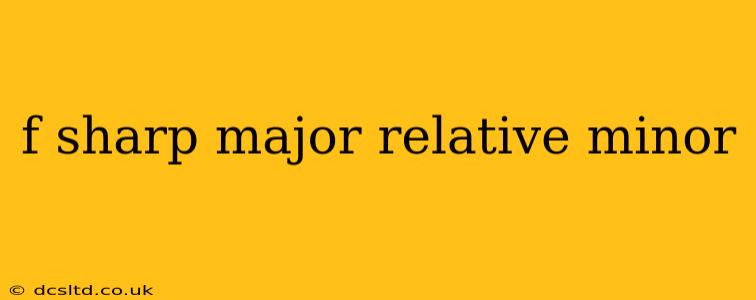F# major and its relative minor, D# minor, share a fundamental connection rooted in music theory. Understanding this relationship unlocks a deeper appreciation for harmony and composition. This exploration will delve into the specifics of this key relationship, answering common questions musicians often have.
What is a Relative Minor?
Before we dive into the specifics of F# major and its relative minor, let's establish the definition. A relative minor is a minor key that shares the same key signature as a given major key. In simpler terms, they both use the same notes, just starting on a different note. This means they'll have the same sharps or flats in their key signatures.
What is the Relative Minor of F# Major?
The relative minor of F# major is D# minor. This is because D# minor shares the same six sharps (F#, C#, G#, D#, A#, and E#) as F# major. This shared key signature is the defining characteristic of relative keys.
How are F# Major and D# minor related?
The relationship between F# major and D# minor lies in their shared notes. Both keys use the notes: F#, G#, A#, B, C#, D#, and E#. The difference lies in their tonic (starting note). F# major uses F# as its tonic, while D# minor uses D# as its tonic. This simple shift in the starting note creates a dramatically different feel and character, despite the shared notes.
Why does D# minor sound "darker" than F# major?
This is due to the inherent nature of major and minor scales. Major scales are typically perceived as brighter, happier, and more uplifting, while minor scales are often described as darker, more melancholic, or introspective. The intervallic structure of the scales contributes significantly to this perception. The major scale's characteristic major third interval (a wider interval than the minor third) contributes to its brighter quality.
Are F# Major and D# minor interchangeable?
While they share the same notes, F# major and D# minor are not directly interchangeable in most musical contexts. Their distinct tonality—the major or minor feeling—creates a substantially different musical effect. Switching between them might dramatically alter the mood and character of a piece. However, they can be used in conjunction within a single composition, often for creating harmonic interest or contrast.
What are some common uses of F# Major and D# minor together?
Composers frequently use the relationship between relative major and minor keys for creating harmonic richness and emotional depth. Transitions between F# major and D# minor can be subtle or dramatic, depending on the composer's intent. Think of it as adding a contrasting shade to a painting; it enhances the overall impact. One could use F# major as the main theme and introduce D# minor for a bridge or contrasting section.
Can I modulate between F# Major and D# minor easily?
Modulation, the process of changing keys, between relative keys is generally easier than between keys with different key signatures. Because they share the same notes, the transition can be smoother and more natural-sounding. However, the specific approach to modulation will depend on the context and the desired musical effect.
Conclusion: Mastering the Relative Key Relationship
Understanding the relative minor of F# major (D# minor) is crucial for any musician. This knowledge helps unlock a deeper understanding of harmony, composition, and the emotional nuances of music. By exploring the subtle differences and shared characteristics of these keys, you’ll be better equipped to craft compelling and engaging music.
